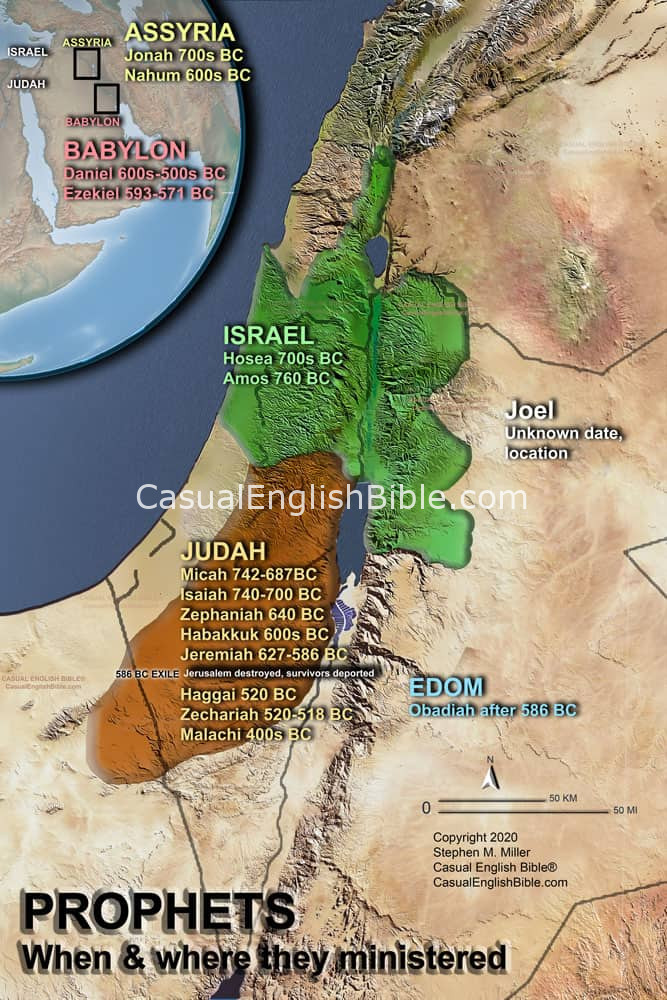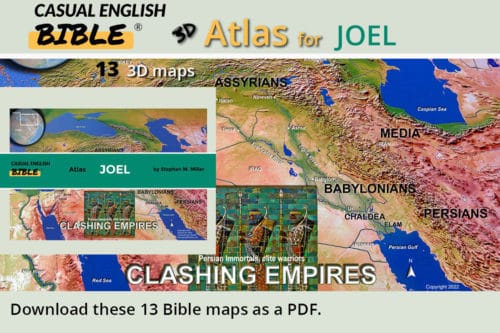Intro notes for Joel
Invaders are coming like a swarm of locusts. That’s God’s message, as told by a prophet named Joel.
A few nibbling grasshoppers aren’t much of a problem. But in the Middle East, an angry swarm of hungry grasshoppers can explode up out of the desert sand and morph into a dark cloud big enough to blacken the sky and pose for photos shot from space.
The biggest swarms come from African and Arabian deserts where there aren’t many critters with an appetite for grasshoppers. When conditions are perfect for grasshoppers to propagate, swarms can soar a mile high before dropping onto a green and brown patch of grain, fruit, and vegetables.
In modern times, swarms have been measured at 80 million locusts per square kilometer.
They can wipe out grain fields, vineyards, and olive orchards—along with most every other plant eaten by people, livestock, and wild animals. When wild animals begin starving, livestock and people begin looking tastier.
No wonder locusts show up on the kosher menu of the Hebrew ancestors of today’s Jewish people: “…locusts, crickets, and grasshoppers. Eat any of them you like” (Leviticus 11:22).
Locusts, symbol for invaders
Joel used locusts to describe what invaders were going to do to the nation: Decimate it by stripping it bare to the bark. That’s a metaphor.
What locusts did to a farmer’s field, invaders would do to people, livestock, and cities in their path.
Joel warned that God was sending the invaders to punish the people for breaking their contract agreement to obey God in exchange for peace and prosperity.
“If you don’t follow the law and you refuse to do what the LORD your God says…You’re going to have some painful experiences in your families, fields, flocks, and herds” (Deuteronomy 28:15-17).
“You can do this”
Joel’s message in a paragraph:
“It’s not too late, the LORD says.
Come back to me
With all your heart,
With fasting, crying, and sorrow.Don’t tear your clothes in grief, though.
Open your hearts instead.
Go back to the LORD. He’s your God.
He’s kind and full of mercy.
…His love won’t quit.
And the last thing he wants to do is punish” (2:12-13).
They didn’t listen
The most common educated guess among Bible scholars is that the people didn’t do what Joel said. So, God did what he didn’t want to do.
A nation, possibly Judah, got wiped off the map.
As the Bible tells Judah’s story, invaders left no leaders and few survivors. Most who survived the battles were killed or deported to what is now Iraq.
WRITER
“The LORD gave this message to Joel, who was the son of Pethuel” (1:1).
Joel doesn’t show up anywhere else in history, as far as Bible scholars say they can tell. Everything beyond Joel’s first sentence in the introductory categories of Writer, Timeline, and Location are educated guesses, at best.
TIMELINE
It’s uncertain when and where Joel lived. Clues prompt guesses that span 500 years.
Some scholars put him first among the “major” and “minor” prophets, as the prophets were called, whose names are attached to Bible books. The timeline stretches from about 800 BC-300 BC. A sampling of timeline clues:
Early date, before Babylon leveled the city in 586 BC
Jerusalem still seemed to have walls and the Temple (2:7, 17). That suggests Joel lived before Babylon flattened the city. But Joel could have been describing the city from a historian’s point of view.
Middle date, after Babylon destroyed Jerusalem
He doesn’t mention a king. That suggests he lived after 586 BC, when Jewish kings were just memories. Babylonian invaders destroyed Judah’s cities, including Jerusalem and the Temple—and deported and exiled many survivors.
Late date, when Jews are returning to Israel half a century later, or more
Joel says Jews were getting sold to Greeks. But Alexander the Great didn’t put Greeks on the map until the 300s BC, more than two centuries after Babylon erased Judah from the map in 586 BC. So, this reference to the Greeks is one reason some scholars have argued that Joel wasn’t writing prophecy about the future, he was writing history as a poem.
Yet other scholars say Greeks were alive and well long before Alexander. The prophet Ezekiel lived during the Babylonian Exile in the 500s BC, when Jews were deported and living in what is now Iraq. Ezekiel mentioned Tyre’s slave trade with Greeks (Ezekiel 27:13). Tyre was a coastal city in Phoenicia, now Lebanon.
LOCATION

Identifying Israel or Judah as the target may not have mattered to Joel.
If Israel was already gone, ended in about 722 BC by Assyrians, only Judah was left. So, it would have been obvious to the original audience who Joel was talking about.
And if Israel was still there, and if invaders were any of the big names from the East—Assyrians or Babylonians in Iraq or Persians in Iran—they would invade from the north. They would plow through the northern Jewish nation of Israel and continue into the southern nation of Judah. Most invaders did just that.
PURPOSE
Joel used horrifying word pictures to warn the people they were about to be swallowed up by an invasion force.
To stop the attack, the listeners—whoever they were—needed to turn their nation back to God.
If the common educated guesses are right, the people didn’t go back to worshiping God until after their nation disappeared, erased from the map.
The people had broken their contract agreement with God and were left wondering if they were still the Chosen People. They had land. They had no Temple. For all they knew, they had no God who wanted anything more to do with them.
Yet Joel gives the Jewish people hope. As all the prophets do.



